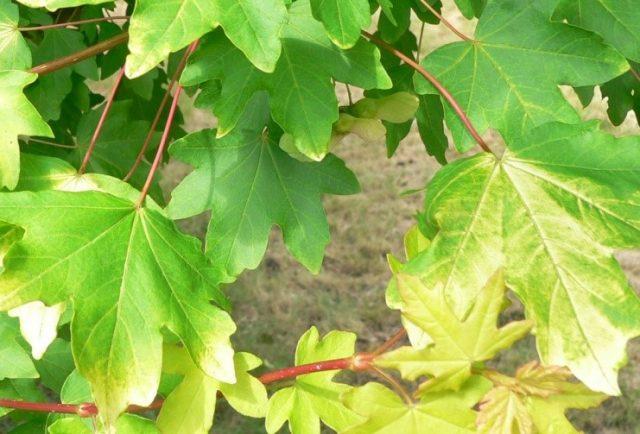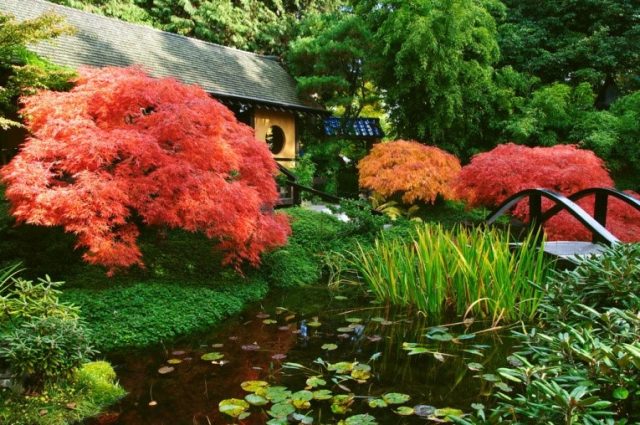Content
Deciduous and coniferous trees are an important element of landscape design. Decorative species are used to create pictorial compositions. Field maple, distinguished by its beautiful crown shape and brightly colored foliage, is invariably one of the popular plants that form garden, park and urban landscapes.

In autumn, maple alleys delight with the golden-crimson coloring of leaves
Description of field maple
Field maple is a plant species of the Maple family. It is common to see short trees on sidewalks and in city parks. In recent years, maple tree plantings have been decorating playgrounds, country villages and other socio-cultural areas. Plant seedlings easily take root in almost any area. Main biological characteristics of field maple:
- in a temperate climate zone, the height of trees does not exceed 15 m, but in the southern regions you can find 25-meter giants;
- a straight or slightly curved trunk reaches 60 cm in diameter;
- the bark is brown, heterogeneous, mottled with longitudinal lines;
- the natural shape of the crown resembles a wide cone, gradually tapering towards the top;
- rich green foliage;
- the figured leaf of the field maple consists of five or seven lobes;
- small flowers appear in spring at the same time as foliage;
- winged seeds are formed by fused symmetrical halves.
The tree grows very quickly: under favorable conditions, it can gain 50 cm in height and 30-40 cm in width in a year. Field maple is one of the few trees that independently forms a dense, symmetrical crown. Even the trunks of this tree species are decorative. Many of them are covered with a “snake” pattern. The bark is an alternation of vertical stripes of different shades of gray, brown, green, black.
The question of the honey productivity of field maple remains open. Some reference books attribute a high level of melliferous properties to the plant. Botanists consider this information unreliable. The fact is that trees bloom in April, while bees begin collecting honey in May.

The seeds are able to remain in the air for a long time, thanks to which the maple populates the territory naturally
Field maple varieties
There are 150 species of maples in the world. Decorative tree varieties attract visitors with their beautiful leaf shape, thick crown, expressive pattern on the bark, and unusual combination of natural colors.
Ordinary
The most common maples in Russia are common field maples. This species can be found in almost all climatic zones, since the trees tolerate cold and heat equally well.

Common maple belongs to the category of fast growing trees
Hensus Variegatum
A special feature of maples of the Hensus Variegatum variety is the creamy green color of the foliage. In the distance, the tree crowns appear beige.

The variety Hensus Variegatum grows best in open space
Carnival
Maples of the Carnival variety look very elegant - carved green leaves along the edges are framed by a milky border. Young foliage may have a pink tint. Miniature trees do not reach 3 meters in height.

If carnival is damaged, it is promptly pruned so that the crown becomes woody before the onset of winter.
Postelens
The young foliage of Postelens maples has a golden hue in spring. With the onset of summer, the color of the crown becomes dark green, and in the fall the leaves acquire a rich yellow color.

A special feature of the Postelens variety is the red petioles of the leaves.
Red Shine
A short tree (less than 5 m) with grayish bark and a spreading crown is a field maple of the Red Shine variety. In spring, yellow-green buds are formed on the branches, collected in inflorescences. The leaves of the Red Shine field maple are bright red and large-lobed.

The Red Shine variety is distinguished by unusually openwork leaves
Nanum
The most popular variety of field maple in city parks and squares is Nanum. A spherical crown, small leaves with deep cuts, dark green color in summer and golden color in autumn are visual qualities that make the tree popular when decorating urban areas and local areas.

Nanum tolerates heat well, retaining foliage even in dry summers
Features of cultivation
Numerous varieties of maple trees are distinguished by their unpretentiousness and high adaptive qualities. Gardeners are especially attracted to the ability of maples to tolerate pruning and crown shaping with wire without problems. In the right place and with good care, field maple lives for more than 100 years.There is reliable information that the age of individual trees is close to 500 years.
Reproduction
The field species can be propagated by seeds, cuttings and seedlings. Experienced gardeners graft decorative forms onto trunks. The easiest way is propagation by seedlings. When choosing planting material, you should consider a number of recommendations:
- seedlings about 1 m high take root best; they are strong enough not to break from the wind;
- you should pay attention to the development of the roots; seedlings that are 2-3 years old have strong rhizomes;
- It is advisable to purchase planting material from specialized nurseries, since on the market, instead of miniature varieties, you can get trees 15 m high.
Field maples can be planted in both spring and autumn. In the case of planting a large plant (a seedling more than 1.3 m high), the procedure should be planned for the second half of October in order to preserve the earthen ball entwining the roots unharmed.
Open, spacious areas are suitable for cultivating all varieties of maple. The decorative qualities of the breed are best seen in sunlit areas. Although field maple is unpretentious, the tree takes root and develops best on fertile soils.
The algorithm for planting a seedling is as follows:
- A hole is prepared with a diameter of 70 cm and a depth of 50 cm.
- When the soil is clayey and close to the groundwater surface, a drainage layer is formed.
- The seedling is placed in the hole so that the root collar is at ground level.
- The hole is filled with a nutrient mixture, including compost, turf soil, sand in a ratio of 3:2:1.
- The surface of the hole is compacted, and a low side is formed around it (so that water does not flow out of the hole).
- The seedling is watered with two buckets of water.
Within a month after planting, the young tree is watered twice a week. The required one-time volume of water is 15-20 liters. During the dry summer period, water consumption increases to 30 liters. After the seedling has taken root, spring watering is carried out only in case of prolonged absence of precipitation.

To make the seedling take root faster, wooden support sticks are used
In order for the tree to develop safely, it must be fed in a timely manner. Field maple requires mineral fertilizers. At least twice a season, the soil around the trunk is loosened, as well as mulched with black soil or peat.
Spring tree care work necessarily includes pruning and removing damaged and dried branches. If there is a need to mold the crown, then it is best to plan pruning at the end of March, and in the southern regions - in the first days of spring.
Diseases and pests
All decorative types of field maple are little susceptible to diseases. Proper care is the key to healthy trees. Diseases arise as a result of a violation of the care process: with excessive watering and an excess of mineral fertilizers. During prolonged rains, regular weeding is required so that excess water goes into the ground naturally.
The main pests of field maple are gall mites, aphids, whiteflies and maple leaf beetles. Plantings of non-fruit trees can be safely treated with insecticides. The most effective systemic drugs are:
- Confidor;
- The spark is golden;
- Aktara;
- Tanrek.
Analog drugs containing the active substances imdacloprid and thiamethoxam can also be used. These chemical compounds are effective after the first use. Modern pesticides are toxic to insects and have virtually no harmful effects on humans.
Japanese maple in landscape design
Decorative maple varieties are a frequently used element of landscape design. Japanese species are especially willing to be used when creating landscaped natural areas.
The most popular design option is that different varieties of trees are planted along the paths in such a way that a gradation of colors from yellow to purple is noticeable. An equally interesting design solution for a park or garden area is a harmonious combination of decorative maples and stones near a miniature natural or artificially created reservoir.

Landscapes with Japanese maples look impressive, but the trees require insulation for the winter
A modern method of landscape design is bonsai. The technique involves the formation of figured plants in pots (containers). The unusual contour of the tree is created using pruning and wire devices.
Innovative design techniques also include creating gardens in Japanese or Alpine style; decoration of verandas, terraces, rockeries and mixborders with decorative maples.

In the warm season, bonsai are taken outside and picturesquely placed on the site
Conclusion
Field maple is a wonderful tool for landscape design.Decorative varieties are planted to create cozy landscapes and purify the air from dust and harmful chemicals.








